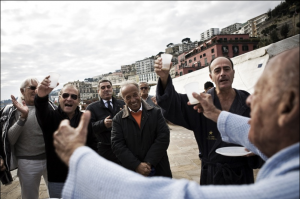
“An oasis of luxury in the capital of mafia” was the title chosen by a peruan newspaper in publishing this photo reportage about Naples’ Circolo Posillipo. But in spite of many elements that might make us believe it, we can’t pretend that Napols is just like a stereotype of a South American city, where the rich lock up in their golden bunkers, while in the streets the people shoot each other with guns. Partly because the members of Circolo Posillipo are not as rich as we could imagine; but mainly because Naples, as south american cities are, is a place far more complex than the unambiguous narrations we receive from the media, that now only see/sell the violent deaths, criminality, urbanistic and social chaos, while in the Nineties they only showed the monuments that were reopening, the dynamism of the new upper classes, and the rebirth of tourism. Even them the camorra controlled the neighborhoods, the peripheries were second-class places, the young people were beginning to assume crack and cocaine, hidden by the invisibility in which they were being kept. All these things, at that time, were not so fashionable as they are it now.

Just as well, when the media (local and national) talk about napolitan workers, like it happens now in the case of the 5000 car workers of the Fiat plant at Pomigliano d’Arco, laid off and depending on unemployment benefits since two years ago, we have to watch out not to get trapped into simplifications, like contrasting automatically two images: the rich and the poor, idleness and hard work, privilege and exploitation. This is what appears most evident: but we better try and look at it closely: who are they, where do they come from, what do they strive for, those last representatives of a residual working class, that in the present context of widespread unemployment, can still be considered as a bunch of “privileged” workers.
That’s it, black or white. For a city like Naples, it has always been like this. But those who tried, and are still trying, to understand it better, can’t be taken in by appearances. This is why experiences like this one are so important: to help us understand the shades.
- Carola Pagani‘s Reportage and article on Circolo Posillipo
- Trailer of Luca Rossomando‘s documentary movie “La fabbrica incerta”, on Fiat plant at Pomigliano d’Arco
- Webpage of Napoli Monitor, monthly review of croniques, drawings, reportages.